Drawing from decades of lunar research, including Apollo mission rock samples and advanced satellite observations, scientists have uncovered a clear description of how the moon transformed into the celestial body we see today
The theory suggests that about 4.5 billion years ago, a collision between a young Earth and a smaller planet generated a debris cloud that coalesced into our moon.
However, experts say the complex details of this lunar genesis have always been a mystery, resembling a complex “more of a choose-your-own-adventure novel.”
Transformation of the moon
The key to understanding this mystery lies beneath the moon’s calm surface. As the moon rapidly cooled from its molten state, a global magma ocean surrounded it, eventually solidifying into the moon’s mantle and distinctive bright crust. Deep within this primordial moon, a gravitational tug-of-war ensued.
Lead researcher Weigang Liang describes how dense minerals, such as ilmenite rich in titanium and iron, settled beneath the moon’s surface, creating gravitational instabilities.
Over millennia, this dense layer sank into the moon’s interior, mingling with the mantle before resurfacing as titanium-rich volcanic rocks predominantly on the moon’s nearside.
“Our moon literally turned itself inside out,” explains co-author Jeff Andrews-Hanna, emphasising the transformative disruption concealed beneath the moon’s calm face. However, the exact sequence of events remained unknown until now.
Advanced simulations and data from NASA’s GRAIL mission unveiled a groundbreaking discovery. The moon’s gravity field anomalies align with predictions of a sinking ilmenite-rich layer, confirming that these dense remnants cascaded into the lunar interior, leaving behind a distinctive signature detectable from space.
Luna metamorphosis
These findings pinpoint the timeline of this lunar metamorphosis. Liang and colleagues determined that this cataclysmic event, occurring over 4 billion years ago, significantly shaped the moon’s subsequent geological evolution, including the formation of its maria, or dark volcanic plains.
“The moon’s earliest history is written below the surface,” notes Andrews-Hanna, explaining the implications of these revelations for lunar exploration. As humanity gears up for the Artemis missions and a new era of lunar exploration.
The lopsided nature of the moon, with its nearside distinct from the far side in elevation and composition, offers further clues. The overturn of the lunar mantle, intimately linked with the unique characteristics of the Procellarum region, shows the dynamic interplay between the moon’s interior and surface features.
Looking ahead, researchers predict future missions equipped with seismic networks to solve the moon’s subterranean secrets with unprecedented clarity.











